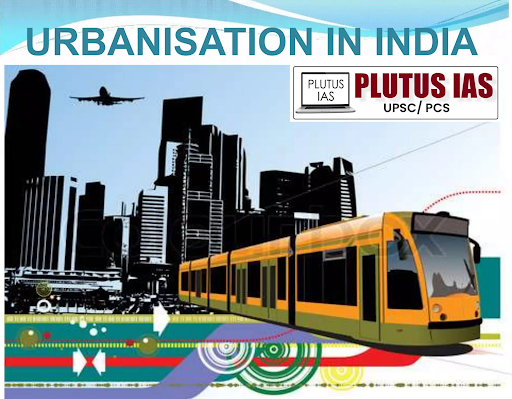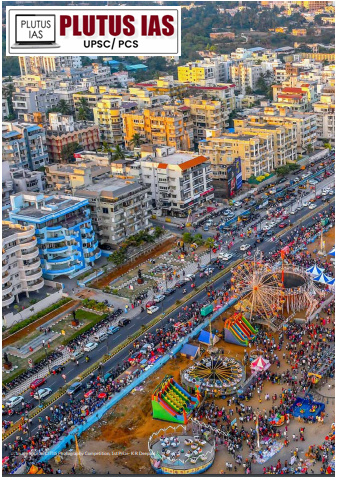25 Nov Building the Future: Urbanization Strategies for Viksit Bharat by 2047
This article covers “Daily Current Affairs” and topic details of Building the Future: Urbanization Strategies for Viksit Bharat by 2047
Syllabus mapping:
GS-1: Indian Society: Urbanization and its challenges and remedies
For Prelims:
What are the schemes related to urbanization and institutions? NLUM, PURA mission, Smart City mission, AMTUT Scheme?
For Mains:
What are the key factors driving urbanization in India, then the challenges faced by urbanization in India, government initiatives, and ways forward for sustainable urbanization?
Why in the news?
India’s urbanization is accelerating, with the urban population expected to double from 400 million to 800 million by 2050. This growth presents an opportunity to transform India’s urban landscape into hubs of innovation, economic growth, and sustainable living. However, it comes with financial and infrastructural challenges requiring targeted policies and investments.

Urbanization Scenario in India
Rapid Growth: India’s urban population is projected to double from 400 million in the last decade to 800 million over the next 30 years, marking a significant shift towards urbanization.
Infrastructure Demand: Meeting urban infrastructure needs by 2036 requires ₹70 lakh crore, against current investments of ₹1.3 lakh crore annually.
Focus on Urban Services: Around 50% of urban infrastructure funds are required for basic services, while the other half is allocated for urban transport projects.
Urban Development Potential: With a growing population, urban centers present an opportunity to transform India’s economic, social, and environmental landscapes.
Population: India has one of the largest urban populations in the world, with more than 377 million people living in urban areas in 2011. By 2036, 40% of India’s population is expected to live in cities.
Economic output: Cities contribute about two-thirds of India’s economic output.
Poverty reduction: Urban growth has accounted for about 80% of India’s total fall in poverty.
Slums: Slums account for about 26% of the urban population in India.
Significance of Urban Centres:
Economic Engines: Urban centers contribute 60-70% of India’s GDP, driving industrial growth and innovation.
Employment Opportunities: They attract talent, fostering entrepreneurship and job creation in various sectors. Cities like Pune, Chennai, and Noida have emerged as the major employment centres
Infrastructure Hubs: Urban areas serve as focal points for transport, communication, and technology infrastructure. Delhi Metro and its infrastructure is a good example in this regard.
Social Transformation: Cities are hubs for education, healthcare, and cultural exchange, enhancing social mobility. For example cities like Guwahati.
Environmental Innovations: Urban centers can lead sustainable practices, including green buildings and renewable energy adoption.
Global Competitiveness: Well-developed cities improve India’s ranking in global indices and attract foreign investments.
Knowledge Clusters: Cities like Bengaluru and Hyderabad thrive as knowledge and technology hubs, spurring innovation.
Sustainable development: for example, cities like Kochi, and Shimla adopted sustainable development which is a precedent for other cities to adopt it.

Challenges Faced by Indian Cities
Financial Constraints: Municipal finances account for only 1% of GDP, and revenue from property tax is a mere 0.15% of GDP.
Inefficient Resource Utilization: 23% of municipal revenues remain unspent; major cities like Chennai utilize only 50% of their budgets.
Lack of Autonomy: Municipal bodies face limited administrative and financial powers, hindering effective governance.
Inadequate Urban Services: Cost recovery for services ranges from 20%-50%, leading to inefficiencies in service delivery.
Poor Infrastructure: Urban transport and housing struggle to meet rising demands, causing congestion and inadequate living conditions.
Low Absorptive Capacity: Cities fail to utilize central scheme funds fully; AMRUT achieved only 80% utilization, and Smart Cities Mission reached 70%.
Declining PPP Investments: Public-private partnerships in urban infrastructure have sharply declined, impacting project viability and bankability.
The Way Forward
Strengthening Municipal Finances: Empower urban local bodies (ULBs) to generate revenue through property taxes and municipal bonds. Eg, AMRUT 2.0 supports ULBs in improving water supply and sanitation.
Boosting Public-Private Partnerships (PPPs): Develop policies to revive PPPs for infrastructure projects. For Example, The Smart Cities Mission promotes private sector involvement in urban planning.
Developing Robust Project Pipelines: Prepare a detailed pipeline of 600-800 urban projects for efficient implementation. Example: The National Infrastructure Pipeline (NIP) focuses on project readiness and investment mobilization.
Leveraging Digital Public Infrastructure (DPI): Use DPI for better urban service delivery and governance. PM Gati Shakti integrates digital platforms for urban development and logistics. This can help to leverage the DPI for urban development.
Land Value Capture: Harness land value around transport hubs to fund metro and rail projects. A scheme like Metro Rail Policy 2017 can help to promote transit-oriented development.
Enhancing Absorptive Capacity: Provide training and tools to municipal staff for efficient fund utilization—15th Finance Commission grants for capacity building in ULBs.
Climate Resilient Cities: Incorporate climate adaptation strategies in urban planning. The National Action Plan on Climate Change (NAPCC) focuses on sustainable urban development.
Empowering Municipalities: Provide greater financial and administrative autonomy to ULBs. The Urban Infrastructure Development Scheme for Small and Medium Towns (UIDSSMT) supports decentralization.
Conclusion:
In a nutshell, by addressing these challenges with targeted reforms and leveraging government initiatives, India can create sustainable, inclusive, and efficient urban centers that meet the needs of its growing population.
Download Plutus IAS Current Affairs ENG 25th Nov 2024
Prelims Questions:
Q. With reference to the National Institute of Urban Affairs (NIUA), consider the following statements:
1. NIUA was established in 1976 as an autonomous body under the Ministry of Health and Family Welfare.
2. The primary focus of NIUA is to address the challenges of rural development in India.
3. NIUA provides technical assistance for city and state-level projects and develops customized training programs.
4. The institute addresses six major thematic concerns, including Urban Governance and Climate Change.
How many of the above-given statements are correct?
A. Only one
B. Only two
C. Only three
D. All four
ANSWER: B
Mains questions:
Discuss the significance of urbanization in Tier 2 and Tier 3 cities in achieving India’s goal of becoming a developed nation by 2047. Highlight the challenges these cities face and suggest measures to address them through effective governance and policy interventions.
(Answer in 250 words)



No Comments